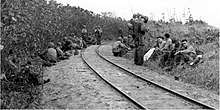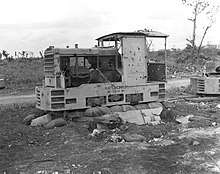Rail transport on the Mariana Islands
Rail transport on the Mariana Islands was mainly related to the transport of sugar cane and military supplies by narrow gauge railways.
Saipan

Japanese business man, Haruji Matsue, that introduced sugar cane farms and narrow gauge railways to the Island of Saipan in the 1920s.[1] A narrow-gauge railway with a gauge of 760 mm (2 ft 5 15⁄16 in) nearly circled the island of Saipan and has been used by the Japanese for transporting sugar cane and military supplies.[2][3] The operation of the railway from Charan-Kanoa to the Aslito air field was taken over by a US-American Seabee detachment, part of the 4th Mar. Regiment under their commander Lt. Comdr. William G. Byrne of Butte, Montana. He has had focussed on re-using the railway, since he saw it on a map, and was lucky that former operators had not sabotaged its approximately 100 miles of track or rolling stock. The Seabees took-over nine locomotives, but two of them were impossible to recommission. Three of them were running by 22 July 1944, though, and the other four were be repaired.[4]
The US-Americans finally used one diesel locomotive and three steam locomotives, and recommissioned 100 flat cars. The railway was operated by the 1398th Engineer Construction Battalion. At the end of July 1944 the traffic volume was 150 tonne-miles (240 tonne-kilometres) per day.[2][5][6] However, rail transport proved to be unfavourable on the Island overall, so that the rails were dismantled and a road was built on their route with the existing right of way. Two of the steam locomotives were then successfully used to sterilize waste bins.[2] One locomotive has been plinthed in Sugar King Park, Garapan, Saipan.[7]
Rota and Tinian
By 1925 Matsue had built an alcohol factory and ice plant (NKK) on Saipan, planted over 3000 hectares of sugar. Subsequently, he established similar facilities on the neighbouring islands of Rota and Tinian. Each of the plantations had its own narrow gauge railway network. The mills were destroyed during World War II and did not reopen. As a relic of the railway a locomotive has been preserved on the island of Rota.[7]
Guam

Two Japanese narrow-gauge diesel locomotives were photographed on 5 October 1944, while being placed on wooden beams at the airfield on the Orote Peninsula in Guam. They were used as cover during the Landing of US-American troops and thus severely damaged. It is not known, whether they were previously used for rail transport or had only just been delivered shortly before the landing of the US-American troops.[8] There are no railway tracks shown on the peninsula on maps of that period of time.[9][10]
References
- Sugar King Park - Small but Interesting.
- Karl C. Dod: The Corps of Engineers: The War Against Japan. Government Printing Office, 1966, p. 503-503.
- No. Unknown, Garapan, Mariana Islands. Retrieved on 1. August 2018.
- John B. T. Campbell jr.: Captured Saipan Railroad Now Managed By Seabees. Marine Corps Chevron, 22 July 1944. Retrieved on 1 August 2018.
- History of the 1398th Engineering Construction Ballallion.
- Comments by Col. Brown regarding the draft of Karl C. Dod's book, EHD files.
- Glyn Williams: Railways in the Northern Mariana Islands. 2016-2017. Retrieved on 1 August 2018.
- United States National Archives, Identification Code: 80-G-247812.
- Capture of Orote Peninsula, 25-30 July 1944. In: Cyril J. O'Brien: Liberation: Marines in the Recapture of Guam.
- Capture of Orote Peninsula. In: Drive to the FBL.